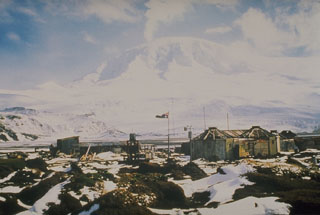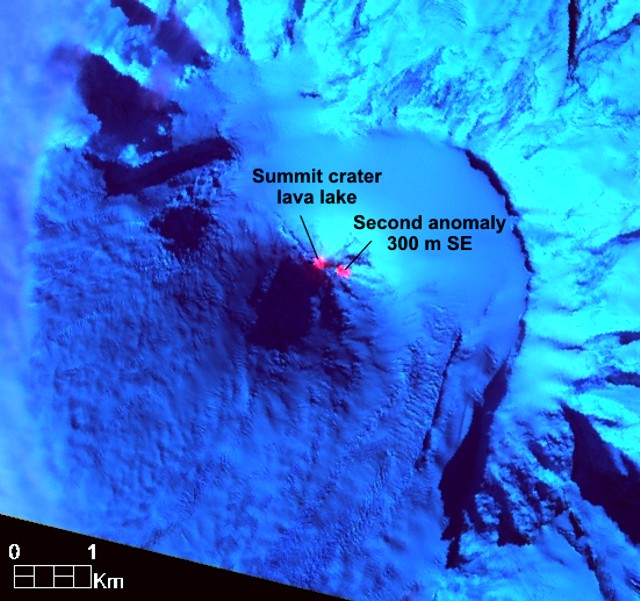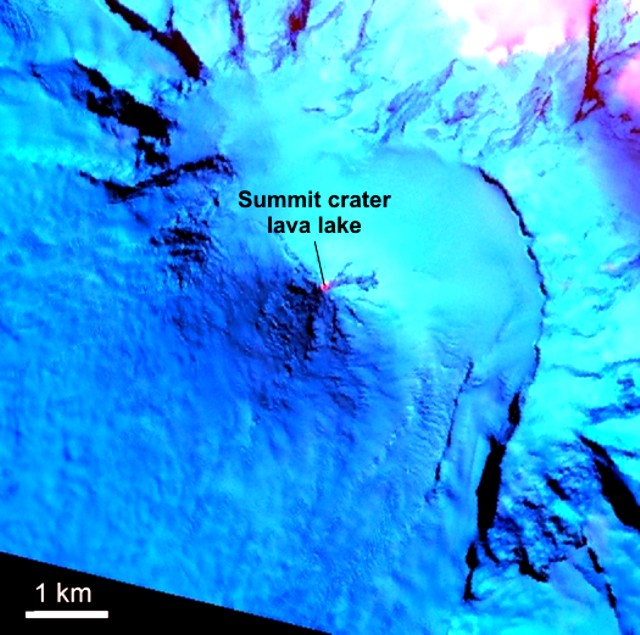Report on Heard (Australia) — March 2007
Bulletin of the Global Volcanism Network, vol. 32, no. 3 (March 2007)
Managing Editor: Richard Wunderman.
Heard (Australia) Thermal anomalies ~300 m apart may suggest two vents
Please cite this report as:
Global Volcanism Program, 2007. Report on Heard (Australia) (Wunderman, R., ed.). Bulletin of the Global Volcanism Network, 32:3. Smithsonian Institution. https://doi.org/10.5479/si.GVP.BGVN200703-234010
Heard
Australia
53.106°S, 73.513°E; summit elev. 2745 m
All times are local (unless otherwise noted)
An ASTER image over Heard for 29 February 2007 (figure 11) was found by Matt Patrick in which two thermal anomalies are shown, separated by ~ 300 m. The anomaly to the SE appeared to be a new feature, representing either a distinct vent or a hot distal portion of an active flow from the main vent. There are no anomalous shortwave pixels between the two anomalies as one might expect for an active lava surface, but the flow may be channeled underground between the anomalies. The total lack of anomalous pixels in the region between the two anomalies, however, caused Patrick to suspect that this is a distinct vent. If this is a distinct vent, it would be the first clear illustration of multiple vents at Heard. None of the previous images Patrick has studied covering the last 6 years (including the 8 December 2006 image, also using Band 9-3-1 color mapping, shown in figure 12) showed indications of a secondary anomaly.
MODIS satellite data also revealed thermal anomalies on 24 different days between 27 December 2006 and 6 April 2007 (table 3).
Table 3. Thermal anomalies at Heard from mid-December 2006 to early April 2007 from MODIS satellites. Continued from table in BGVN 31:05. Courtesy of Hawai'i Institute of Geophysics and Planetology (HIGP) Hot Spots System.
| Date | Time (UTC) | Pixels | Satellite |
| 27 Dec 2006 | 1845 | 1 | Terra |
| 29 Dec 2006 | 1830 | 1 | Terra |
| 31 Dec 2006 | 1820 | 2 | Terra |
| 31 Dec 2006 | 2005 | 1 | Aqua |
| 09 Jan 2007 | 1815 | 2 | Terra |
| 19 Jan 2007 | 1850 | 1 | Terra |
| 04 Feb 2007 | 1900 | 1 | Aqua |
| 05 Feb 2007 | 1940 | 1 | Aqua |
| 07 Feb 2007 | 1930 | 2 | Aqua |
| 16 Feb 2007 | 1925 | 1 | Aqua |
| 21 Feb 2007 | 1940 | 1 | Aqua |
| 26 Feb 2007 | 0445 | 1 | Terra |
| 05 Mar 2007 | 1820 | 2 | Terra |
| 07 Mar 2007 | 1810 | 1 | Terra |
| 11 Mar 2007 | 1745 | 1 | Terra |
| 12 Mar 2007 | 1825 | 2 | Terra |
| 12 Mar 2007 | 2015 | 1 | Aqua |
| 14 Mar 2007 | 1815 | 1 | Terra |
| 14 Mar 2007 | 2000 | 2 | Aqua |
| 18 Mar 2007 | 1935 | 1 | Aqua |
| 20 Mar 2007 | 1925 | 1 | Aqua |
| 24 Mar 2007 | 1850 | 1 | Terra |
| 26 Mar 2007 | 0505 | 1 | Terra |
| 27 Mar 2007 | 1745 | 2 | Terra |
| 28 Mar 2007 | 2015 | 2 | Aqua |
| 29 Mar 2007 | 1920 | 1 | Aqua |
| 06 Apr 2007 | 0450 | 1 | Terra |
Geological Summary. Heard Island on the Kerguelen Plateau in the southern Indian Ocean consists primarily of the emergent portion of two volcanic structures. The large glacier-covered composite basaltic-to-trachytic cone of Big Ben comprises most of the island, and the smaller Mt. Dixon lies at the NW tip of the island across a narrow isthmus. Little is known about the structure of Big Ben because of its extensive ice cover. The active Mawson Peak forms the island's high point and lies within a 5-6 km wide caldera breached to the SW side of Big Ben. Small satellitic scoria cones are mostly located on the northern coast. Several subglacial eruptions have been reported at this isolated volcano, but observations are infrequent and additional activity may have occurred.
Information Contacts: Hawai'i Institute of Geophysics and Planetology (HIGP) Hot Spots System, University of Hawai'i, 2525 Correa Road, Honolulu, HI 96822, USA (URL: http://modis.higp.hawaii.edu/); Matthew Patrick, Dept. of Geological and Mining Engineering and Sciences, Michigan Technological University, 1400 Townsend Drive, Houghton, MI 49931, USA.



